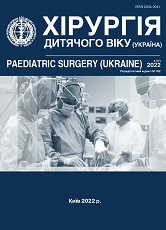The first experience of using robot-assisted surgery in childhood in Ukraine
Keywords:
children, robotic surgery, nosological units, minimally invasive treatmentAbstract
In today's world, high-tech surgical interventions are gaining more and more popularity. Among them is robotic surgery, particularly in childhood.
Purpose - is to present the first experience of using robotic equipment in minimally invasive treatment of children with surgical pathology in one of the largest regional clinics of Ukraine.
Materials and methods. In total, 13 children with different nosological units and different ages were operated on (the youngest child is 6 years old).
Results. When analyzing the results, it was established that robotic surgery has a number of advantages and can be more widely used in children's surgery. The necessary conditions for robotic operations are characterized.
Conclusions. Robotic surgery has a number of advantages and can be more widely used in pediatric surgery. Robotic surgery may expand the range of surgical interventions and decrease the age of patients qualifying for robotic surgery. When installing the equipment, the multi-vector nature of the clinic should be taken into account.
The research was carried out in accordance with the principles of the Helsinki Declaration. The study protocol was approved by the Local Ethics Committee of the participating institution. The informed consent of the patient was obtained for conducting the studies.
The authors declare no conflict of interest.
References
Carsel AJ, DaJusta DG, Ching CB et al. (2022). Robotic upper tract surgery in infants 6 months or less: is there enough space? J Robotic Surg. 16: 193-197. https://doi.org/10.1007/s11701-021-01231-6; PMid:33751338
Chandrasekharam VVS, Babu R. (2022). A systematic review and metaanalysis of open, conventional laparoscopic and robot-assisted laparoscopic techniques for re-do pyeloplasty for recurrent uretero pelvic junction obstruction in children, Journal of Pediatric Urology. 18(5): 642-649. https://doi.org/10.1016/j.jpurol.2022.08.025; PMid:36117037
Chang X, Cao G, Pu J et al. (2022). Robot-assisted anorectal pull-through for anorectal malformations with rectourethral and rectovesical fistula: feasibility and short-term outcome. Surg Endosc. 36: 1910-1915. https://doi.org/10.1007/s00464-021-08473-3; PMid:33877410
Cohen S, Raisin G, Dothan D et al. (2022). Robotic-assisted laparoscopic pyeloplasty (RALP), for ureteropelvic junction obstruction (UPJO), is an alternative to open pyeloplasty in the pediatric population. J Robotic Surg. 16: 1117-1122. https://doi.org/10.1007/s11701-021-01341-1; PMid:34859365
Cundy TP, Marcus HJ, Hughes-Hallett A et al. (2015). Robotic surgery in children: adopt now, await, or dismiss? Pediatr Surg Int. 31: 1119-1125. https://doi.org/10.1007/s00383-015-3800-2; PMid:26416688
Krebs TF, Schnorr I, Heye P, Häcker F-M. (2022). Robotically Assisted Surgery in Children - A Perspective. Children. 9(6): 839. https://doi.org/10.3390/children9060839; PMid:35740776 PMCid:PMC9221697
Lindgren BW, Hagerty J, Meyer Th, Cheng EY. (2012). Robot-Assisted Laparoscopic Reoperative Repair for Failed Pyeloplasty in Children: A Safe and Highly Effective Treatment Option, The Journal of Urology. 188(3): 932-937. https://doi.org/10.1016/j.juro.2012.04.118; PMid:22819409
Matviichuk BO, Huraievskyi AA, Stasyshyn AR, Yurchenko VV. (2007). Laparoskopichna fundoplikatsiia za Nissenom yak metod vyboru khirurhichnoho likuvannia hastroezofahealnoi refliuksnoi khvoroby. Klinichna khirurhiia. 2-3.
Mittal S, Aghababian A, Eftekharzadeh S, Dinardo L, Weaver J, Weiss DA et al. (2021). Primary vs redo robotic pyeloplasty: A comparison of outcomes, Journal of Pediatric Urology. 17(4): 528.e1-528.e7. https://doi.org/10.1016/j.jpurol.2021.02.016; PMid:33766473
Moore ChD, Erhard MJ, Dahm Ph. (2007). Robot-Assisted Excision of Seminal Vesicle Cyst Associated with Ipsilateral Renal Agenesis. Journal of Endourology. 21; 7: 776-779. https://doi.org/10.1089/end.2006.0279; PMid:17705770
Pereyaslov AA, Dvorakevych AA, Bobak AI, Mykyta MM et al. (2019). Comparative analysis of the open and laparoscopic appendectomy in children. Paediatric Surgery. Ukraine. 4(65): 43-47. https://doi.org/10.15574/PS.2019.65.43
Quynh TA, Hien PD, Du LQ et al. (2022). The follow-up of the robotic-assisted Soave procedure for Hirschsprung's disease in children. J Robotic Surg. 16: 301-305. https://doi.org/10.1007/s11701-021-01238-z; PMid:33843006 PMCid:PMC8960593
Shevchuk D, Zaremba V, Vasianovych A. (2022). Endoscopic resection of bladder urothelial neoplasm in a child: a case report. Paediatric Surgery (Ukraine). 2(75): 89-95. https://doi.org/10.15574/PS.2022.75.89
Stasyshyn AR. (2016). Kliuchovi chynnyky uspikhu videolaparoskopichnykh operatsii z pryvodu hastroezofahealnoi refliuksnoi khvoroby ta hryzhi stravokhidnoho otvoru diafrahmy. Klinichna khirurhiia. (12): 13-15.
Downloads
Published
Issue
Section
License
Copyright (c) 2022 Paediatric Surgery (Ukraine)

This work is licensed under a Creative Commons Attribution-NonCommercial 4.0 International License.
The policy of the Journal “PAEDIATRIC SURGERY. UKRAINE” is compatible with the vast majority of funders' of open access and self-archiving policies. The journal provides immediate open access route being convinced that everyone – not only scientists - can benefit from research results, and publishes articles exclusively under open access distribution, with a Creative Commons Attribution-Noncommercial 4.0 international license(СС BY-NC).
Authors transfer the copyright to the Journal “PAEDIATRIC SURGERY.UKRAINE” when the manuscript is accepted for publication. Authors declare that this manuscript has not been published nor is under simultaneous consideration for publication elsewhere. After publication, the articles become freely available on-line to the public.
Readers have the right to use, distribute, and reproduce articles in any medium, provided the articles and the journal are properly cited.
The use of published materials for commercial purposes is strongly prohibited.

